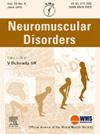包涵体肌炎患者报告和临床评估结果之间的关系——来自回顾性队列研究的见解。
IF 2.7
4区 医学
Q2 CLINICAL NEUROLOGY
引用次数: 0
摘要
包涵体肌炎(IBM)是一种炎症性肌病,以缓慢进展的虚弱、骨骼肌萎缩和异质性临床表现为特征。这种疾病进展和表现的可变性使临床试验中临床进展和干预反应的跟踪复杂化,在确定可靠的结果测量方面提出了挑战。我们的目标是从IBM中选择的最常用的结果测量指标中,找出一套最有用的临床评估和患者报告的结果测量指标(PROMs),用于临床实践和试验。我们回顾性分析了临床评估的结果测量(手动肌肉测试(MMT8, MMT12)),右手和左手握力,改进的计时起跑(mTUG),两分钟步行测试(2MWT);临床管理的患者报告工具(IBM功能评定量表(IBMFRS));和PROMs,包括饮食评估工具(EAT-10)和神经肌肉症状评分(NSS),来自澳大利亚珀斯一家专门的肌炎诊所的20名参与者。相关分析显示,IBMFRS、MMT8、MMT12、mTUG与2MWT之间存在显著相关性(p < 0.05)。NSS与MMT8、MMT12、2MWT呈正相关(p < 0.05)。单因素回归分析显示,2MWT、MMT12和mTUG是IBMFRS和NSS的显著预测因子,反向逐步线性回归显示2MWT是IBMFRS的显著正预测因子(p < 0.001)。总体而言,我们得出结论,IBMFRS、NSS、2MWT和mTUG模型是IBM患者感知身体功能的最佳预测因子。本文章由计算机程序翻译,如有差异,请以英文原文为准。
The relationship between patient-reported and clinician-assessed outcome measures in Inclusion body myositis - insights from a retrospective cohort study
Inclusion body myositis (IBM) is an inflammatory myopathy, characterised by slow progression of weakness, skeletal muscle atrophy, and heterogeneous clinical presentation. This variability in disease progression and presentation complicates tracking of clinical progress and intervention response in clinical trials, presenting challenges in identifying reliable outcome measures. We aimed to identify the most useful suite of clinician-assessed and patient-reported outcome measures (PROMs) for use in clinical practice and trials from a selection of the most commonly used outcome measures in IBM. We retrospectively analysed clinician-assessed outcome measures (manual muscle testing (MMT8, MMT12)), right- and left-handed grip strength, modified timed up and go (mTUG), two-minute walk test (2MWT); a clinician-administered patient-reported tool (IBM Functional Rating Scale (IBMFRS)); and PROMs including the eating assessment tool (EAT-10), and neuromuscular symptom score (NSS) from 20 participants attending a single specialist myositis clinic in Perth, Australia. Correlation analysis revealed significant correlations between the IBMFRS, MMT8, MMT12, mTUG and 2MWT (p < 0.05). The NSS strongly correlated with the MMT8, MMT12 and 2MWT (p < 0.05). Univariate regression analyses revealed that 2MWT, MMT12 and mTUG were significant predictors of the IBMFRS and NSS, and backward stepwise linear regression highlighted that the 2MWT was a significant positive predictor for the IBMFRS (p < 0.001). Overall, we concluded that the IBMFRS, NSS, 2MWT and mTUG models were the best predictors of patient-perceived physical function in IBM.
求助全文
通过发布文献求助,成功后即可免费获取论文全文。
去求助
来源期刊

Neuromuscular Disorders
医学-临床神经学
CiteScore
4.60
自引率
3.60%
发文量
543
审稿时长
53 days
期刊介绍:
This international, multidisciplinary journal covers all aspects of neuromuscular disorders in childhood and adult life (including the muscular dystrophies, spinal muscular atrophies, hereditary neuropathies, congenital myopathies, myasthenias, myotonic syndromes, metabolic myopathies and inflammatory myopathies).
The Editors welcome original articles from all areas of the field:
• Clinical aspects, such as new clinical entities, case studies of interest, treatment, management and rehabilitation (including biomechanics, orthotic design and surgery).
• Basic scientific studies of relevance to the clinical syndromes, including advances in the fields of molecular biology and genetics.
• Studies of animal models relevant to the human diseases.
The journal is aimed at a wide range of clinicians, pathologists, associated paramedical professionals and clinical and basic scientists with an interest in the study of neuromuscular disorders.
 求助内容:
求助内容: 应助结果提醒方式:
应助结果提醒方式:


